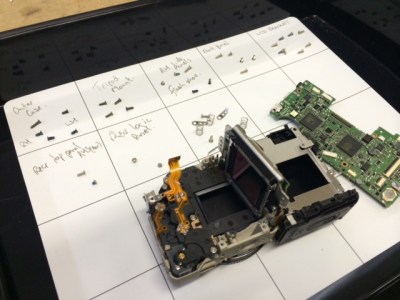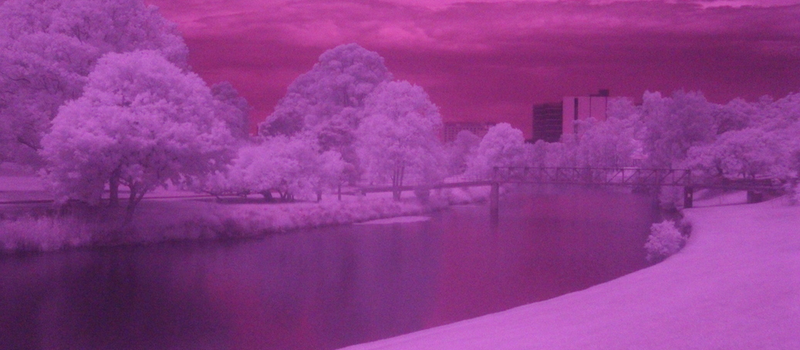The sensor on your digital camera picks up a lot more than just the light that’s visible to the human eye. Camera manufacturers go out of their way to reduce this to just the visible spectrum in order to produce photos that look right to us. But, what if you want your camera to take photos of the full light spectrum? This is particularly useful for astrophotography, where infrared light dramatically adds to the effect.
Generally, accomplishing this is just a matter of removing the internal IR-blocking filter from your camera. However, most of us are a little squeamish about tearing into our expensive DSLRs. This was the dilemma that [Gavin] faced until a couple of years ago when he discovered the Canon EOS-M.
Now, it’s important to point out that one could do a similar conversion with just about any cheap digital camera and save themselves a lot of money (the practically give those things away now). But, as any photography enthusiast knows, lenses are just as important as the camera itself (maybe even more so).
 So, if you’re interested in taking nice pictures, you’ve got to have a camera with an interchangeable lens. Of course, if you’re already into photography, you probably already have a DSLR with some lenses. This was the case for [Gavin], and so he needed a cheap digital camera that used Canon interchangeable lenses like the ones he already had. After finding the EOS-M, the teardown and IR-blocking filter removal was straightforward with just a couple of hiccups.
So, if you’re interested in taking nice pictures, you’ve got to have a camera with an interchangeable lens. Of course, if you’re already into photography, you probably already have a DSLR with some lenses. This was the case for [Gavin], and so he needed a cheap digital camera that used Canon interchangeable lenses like the ones he already had. After finding the EOS-M, the teardown and IR-blocking filter removal was straightforward with just a couple of hiccups.
When [Gavin] wrote his post in 2014, the EOS-M was about $350. Now you can buy them for less than $150 used, so a conversion like this is definitely into the “cheap enough to tinker” realm. Have a Nikon camera? The Nikon 1 J3 is roughly equivalent to the original EOS-M, and is about the same price. Want to save even more money, and aren’t concerned with fancy lenses? You can do a full-spectrum camera build with a Raspberry Pi, with the added benefit of being able to adjust what light is let in.
















I recently did a similar mod on my old Canon 20D, removing the hot mirror (IR filter), but I also converted the camera to monochrome (for narrowband astrophotography) by removing the bayer filter from the sensor. There’s a pretty epic thread about people doing that here: https://stargazerslounge.com/topic/166334-debayering-a-dslrs-bayer-matrix/
It’s a very delicate process removing the CFA without damaging the sensor, but it turned out well for me. Not sure I’d have the cojones to do it with an expensive DSLR though.
There is one company that offers de-bayering. I cant imagine doing that.
“de-bayering”
Wow! That sounds like just the ticket to make the publiclabs home made spectrometer into an actually viable tool. Something to look into for sure.
There are a lot of off the shelf monochrome line CCDs on the market. Building a board to handle those would be a lot cheaper and safer to debayer a ccd. It seems most people physically polish away the filter which can lead to physical damage. I’m wondering if you could use an ion beam gun to etch away the filter.
Yeah, but the typical “publiclabs” spectrometer is using the sensor from a webcam for “spectroscopy on the cheap”. I just wonder if this process could improve the results.
I retired my old Pentax k10d that was featured on here, I had my old Canon 5D Mark II modified by a guy who advertises on ebay and DPReview, it was a bit less than $300 shipped. Even after how careful I was with dust on the k10d mod I still got some under the IR filter so it was nice to have someone do it that had the right setup. This time I went for full spectrum instead of IR only so I could use the camera as a regular color camera with a IR Cut filter on the lens.
I was hoping to do some UV photography with it.. That is until I saw the price of a UV lens like the UV-Nikkor, those things sell for something like $6k used. Some enlarger lenses can be adapted to fit cameras and they let some UV light though. And then UV pass filters start at about $200. Ugh… Ill pass on that one for now.
Well, you could always put together a pinhole for the “lens” and filter the incoming light with wood’s glass to get going with UV.
Thought about that. And specific UV pass filters in that size are much cheaper.
I`d be happy to remove my hot filter for plain infrared on my older DSLR but it’s too risky (don’t wanna mess up the focusing or such), and lifepixel charges more than what the camera is worth… Oh well!
The sensor is still only RGB as far as I understand — i.e. 3-channel, so even if you catch something outside of the visible band you’ll only receive it mixed into one of the channels.., so that’s not that close to what you want for astrophotography where you want the many different bands separated.
And really, do you have to use the phrase *full light spectrum* for just R, G, B and near IR so many times in the text? “The sensor on your digital camera picks up a lot more than just the light that’s visible to the human eye” is it really a lot more?
I was specifically wondering about that, not being intimately familiar with the sensors.
It’s a bit disappointing that they work like that, a true “full light spectrum” could open some pretty amazing possibilities. That would unfortunately require an entirely different “wideband” sensor, one that records frequency and brightness for each pixel.
Do sensors like that exist? I’d guess, if they do, they’re in high end scientific equipment, but, hey, it’s a start…
They do. :)
Look up hyperspectral imaging. Requires a lot of post processing though.
Recording the frequency and brightness for each pixel would be a spectrometer. Imaging spectrophotometers can be built at home.
Technically you’re receiving many different frequencies at each pixel so that would have to be done differently.
Satelites like the Landsat 7 or 8 seem to carry a separate camera for each band and iirc receive about 8 different nonoverlapping bands. I don’t know how different the sensors in them are from our earthly cameras but they’re custom built for other reasons anyway.
Regular cameras are pretty broad spectrum. The pixels have RGB filters in front of them to restrict the pixel pattern (mainly for proper reconstruction). Without the filters you have a high resolution grey-scale image.
I’m not aware this exists. You’d need some sort of spectrometer for every pixel. I’d call this the “mantis shrimp sensor” ;)
Hyperspectral imaging. In some designs they put a diffraction grating over the sensor and an algorithm does the rest.
https://en.wikipedia.org/wiki/Hyperspectral_imaging#Technologies_for_hyperspectral_data_acquisition
Most DSLR and mirrorless sensors ‘see’ IR out to around 1200nm. IR filter starts blocking in the 700nm range: so without the glass you can get most of the NearIR
That is almost a whole “octave” of light that human eyes can’t see. I can’t wait for the multi-layer sensors to come down in price: each sensor pixel records not just the photon flux, but also the wavelength by power. Imagine a common point-and-shoot being able to do false color IR or UV.
All of the pigments in the bayer filter are realitivly transparent to IR so you are using all the pixel site to some degree.
But the camera still does post processing based on the assumption the pixels are behind a bayer filter, as well as smoothing, noise removal, etc, etc. How much this alters the image varies from camera to camera, and some let you make wide adjustments to the parameters that control the process, but in every case what you’ll get is *almost* a near IR image. Still produces some cool effects.
So take the photos in RAW format, and use dcraw or similar to convert without the Bayer blending.
EOS-M is a pretty awful camera, the sensor is noisy as hell and I think you might as well use a damn webcam..
Plus the 1200D was easy to mod too, and that one is at least slightly better than that EOS-M nonsense.
The full spectrum includes ALL frequencies… while this article seems to only be about adding NIR to a mostly-visible frequency detection device. Pretty click-baity title.
Agree. It’s a very disappointing article. Either title the article an ‘IR extended spectrum’ camera, or write an article about a genuine “full” spectrum camera (which, by the way, don’t exist… VLF to gamma rays… I don’t think so).
Instead of modifying a Canon or Nikon mirrorless with limited speed range and aperture settings, fit a Sony Nex to a custom rear door on a Nikon FE (approx 1980) and get speed settings from 1/4000th to over 60 minutes, inexpensive but still awesome lenses, multi spectral, mix and match ASA & ISO to balance RGB or IR on the Nikon light meter and still shoot film when your in the mood.
http://xovercameras.blogspot.com.au
If your good at hacking things, how about hacking the Nex motherboard so we can remove the Nex shutter which is obsolete with this setup.
Enjoy.